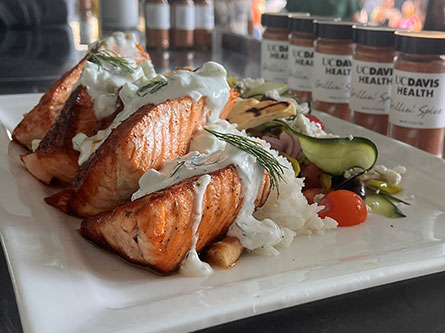Ever had a picky eater in your household? Contrary to some beliefs, picky eating – also known as selective eating – isn’t necessarily a bad thing and can be part of the growing process. About 25 percent of 2-year-olds are considered picky eaters, meaning they refuse to eat food or they eat the same foods over and over.
UC Davis Children's Hospital pediatricians Dean Blumberg and Lena van der List tackled this topic on their podcast Kids Considered. Marybeth Steinfeld, developmental and behavioral pediatrician at UC Davis MIND Institute, joined the pair to offer additional insight.
Listen to the full podcast episode: Picky Eater Parenting
Why are some children picky eaters?
Children don’t like new things. That’s why pediatricians recommend routines, which also applies to their food habits.
Foods with different consistencies can be hard for children to adjust to, often leading to selective eating. In addition, if kids feel pressured to eat certain food, it can make them actively dislike the food.
Another contributing factor to picking eating is getting taste buds to adjust. It can take trying a new food 10 to 15 times before our taste buds get used to it. So, if your child doesn’t like something at first, don’t give up!
Family dinners can help your picky eater
Family meals are an important part of a child’s growth – both socially and with food. Pediatricians encourage parents to regularly share meals with their children.
It’s also important to have no media distractions, such as TV or smart phones, during dinner. Children should learn that eating is a social event. This can help them positively associate fun interactions and eating.
Parents should also demonstrate trying something new and having fun while doing it. Parents can show that new foods can be delicious and often entices children to try something new.
Pediatricians also recommend making the same food for everyone at dinner – don’t make a separate meal just for your picky eater. Offer at least one thing on the plate that the child likes, in addition to the other foods served to everyone for that meal.
6 tips to help parents of picky eaters
- Don’t bribe your child with sweet treats: This makes the treat the preferred food, and the other is still unpleasant. Kids who learn to make deals about food will start doing this for other routine things in their lives, like getting dressed or brushing their teeth.
- Try new foods when your child is hungry: If your child had a big lunch and they’re not hungry, they might be more willing to refuse because they’re not ready to eat again.
- Vary food textures: For children who don’t like certain textures – like mushy foods – try a solid version. For instance, offer apple slices instead of apple sauce. Another trick is to mix solid food with another texture, like dipping animal crackers in apple sauce.
- Arrange the food in creative ways: Place the new food in a happy face shape or add colorful items. Dips and finger foods are great.
- Give the food a fun name: Attaching a nickname to a new food is a great way to distract children. Include your child’s name in the food, like “Peter’s Potatoes.” Or mashed potatoes become “snow mountain super spuds.”
- Involve your child in meal planning and cooking: Take them to the grocery store and let them pick out their favorite fruit or vegetable. Child-friendly cookbooks are great and give kids fun choices to pick from. Kids who help in the kitchen are more likely to want to taste what they make.
Picky eating is a normal part of toddler development – just have patience. Children should be eating some food from every food group. For parents who think their child should be outgrowing the picky eating stage, speech therapists and other health professionals can help your child discover foods they like.




